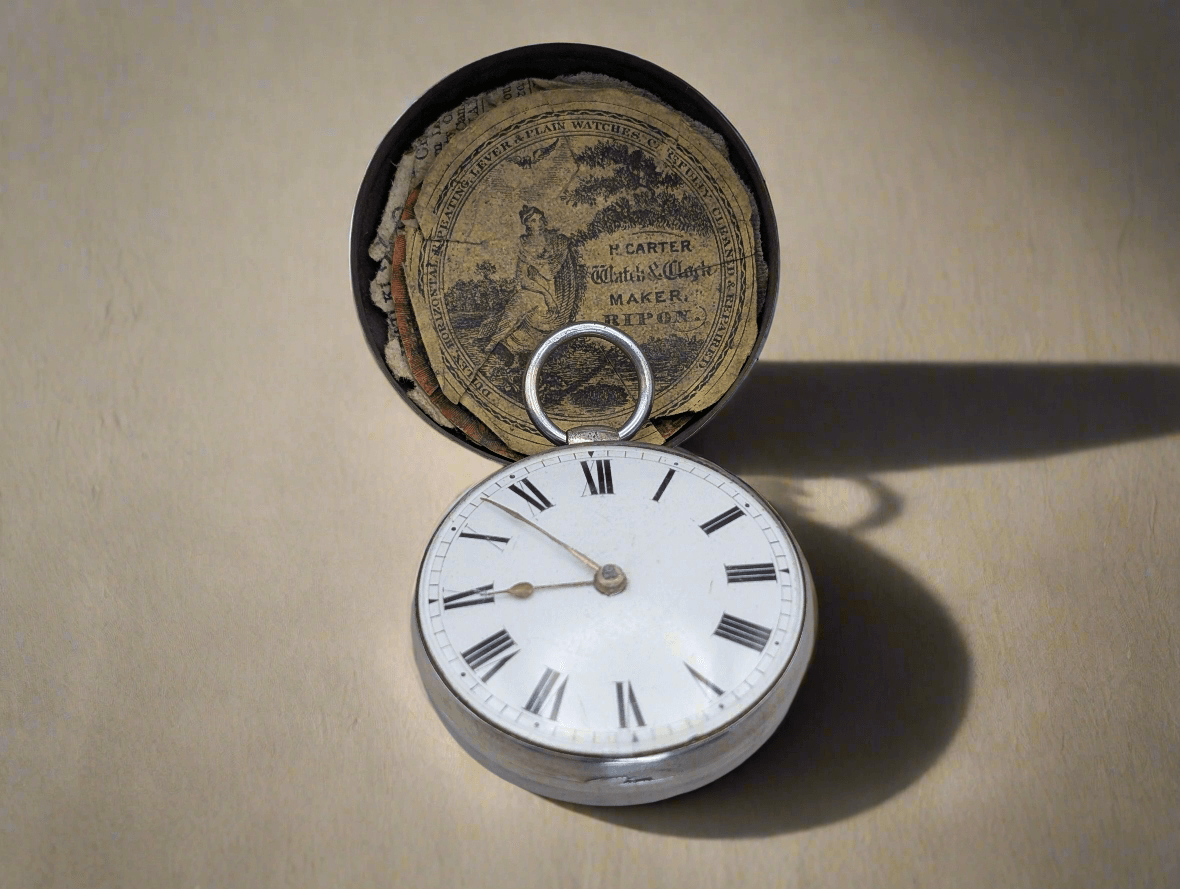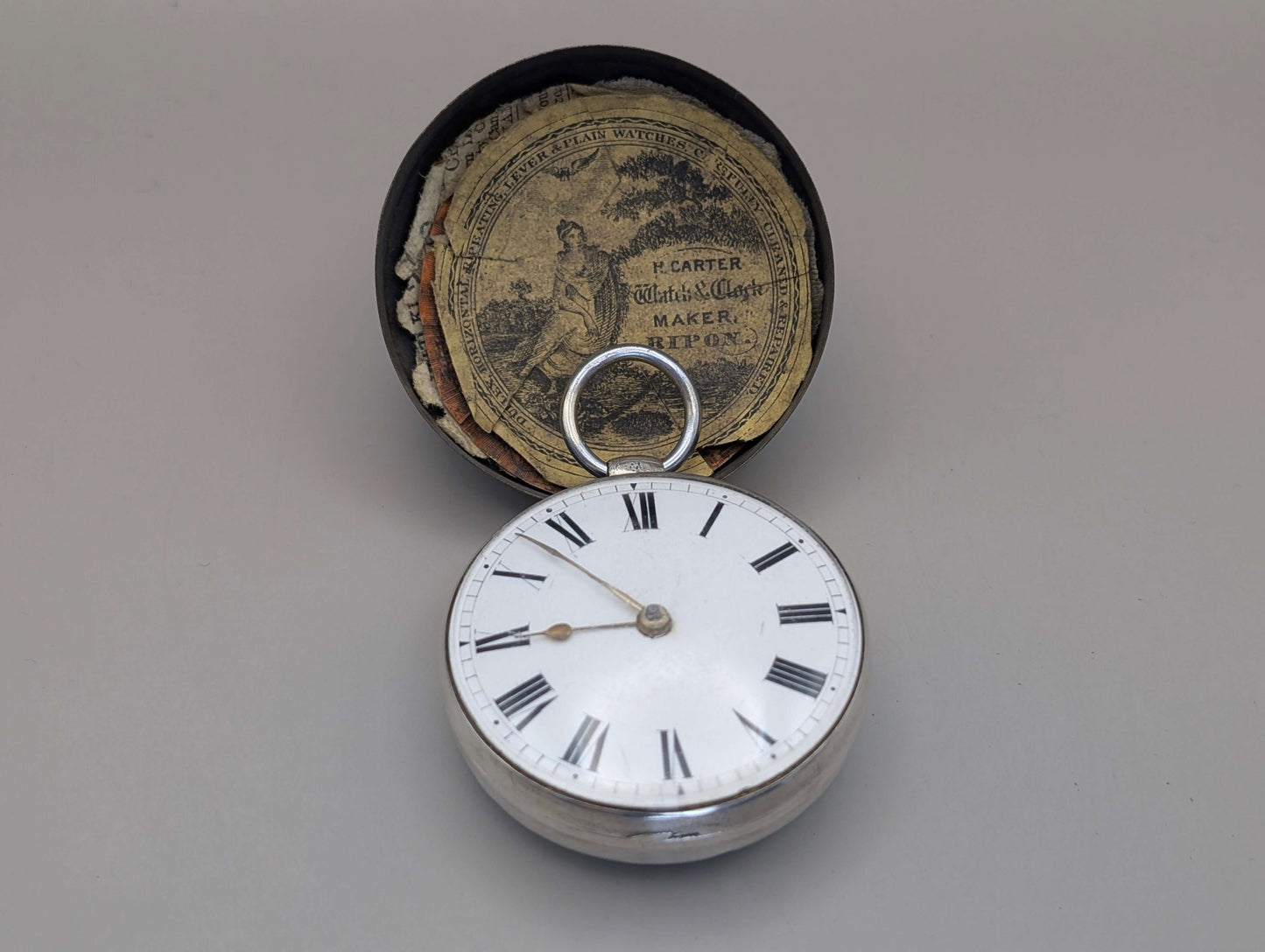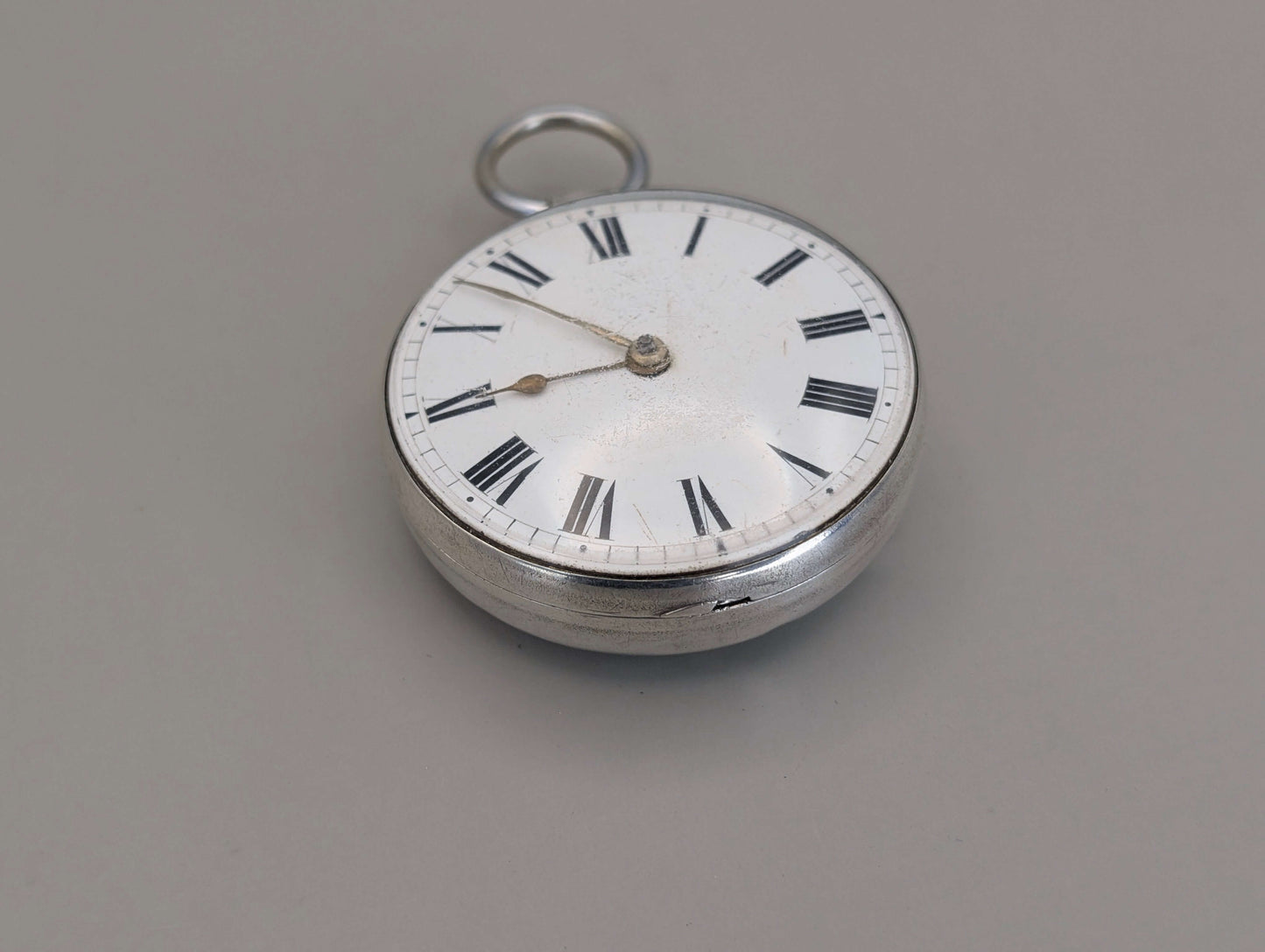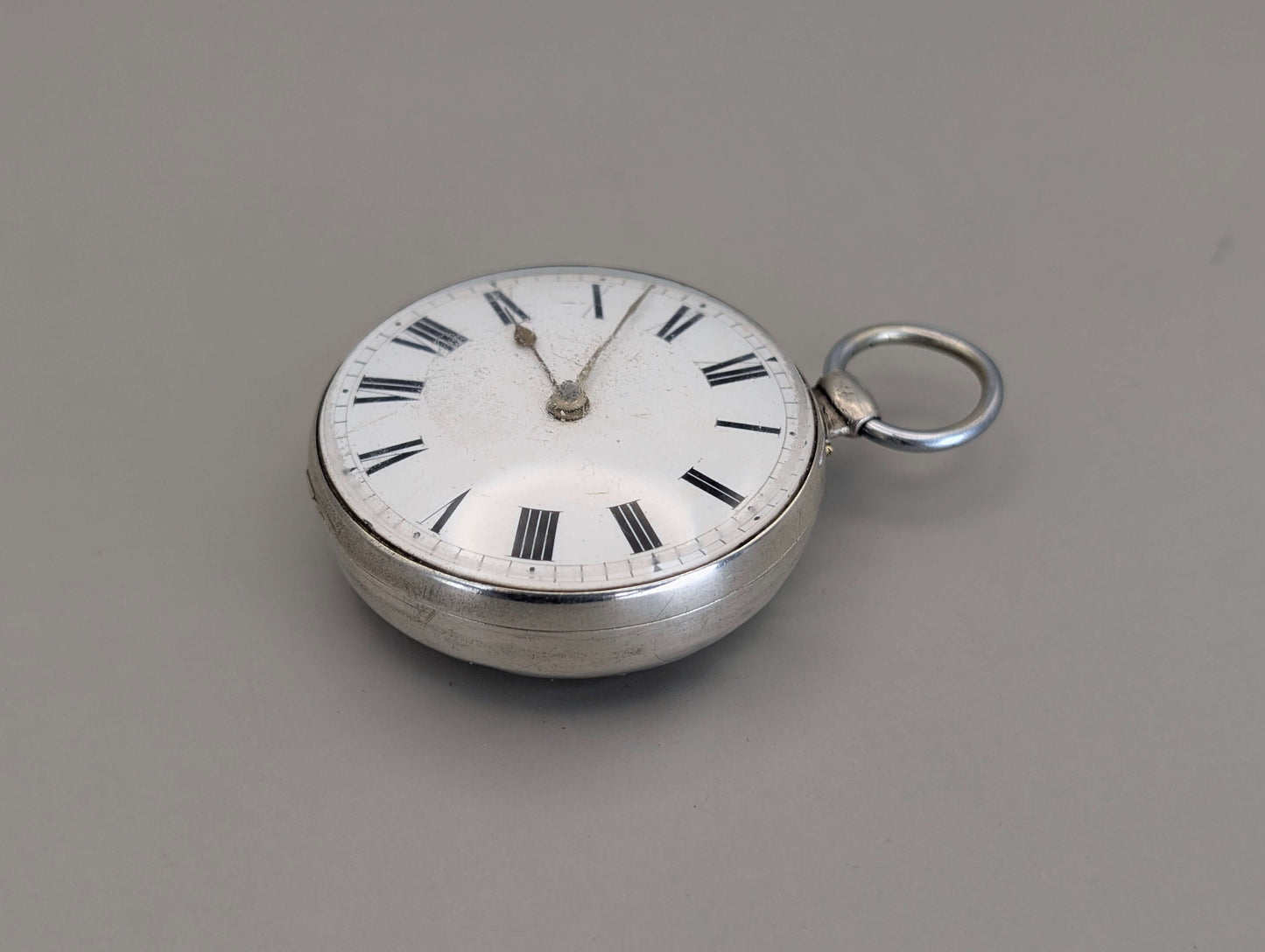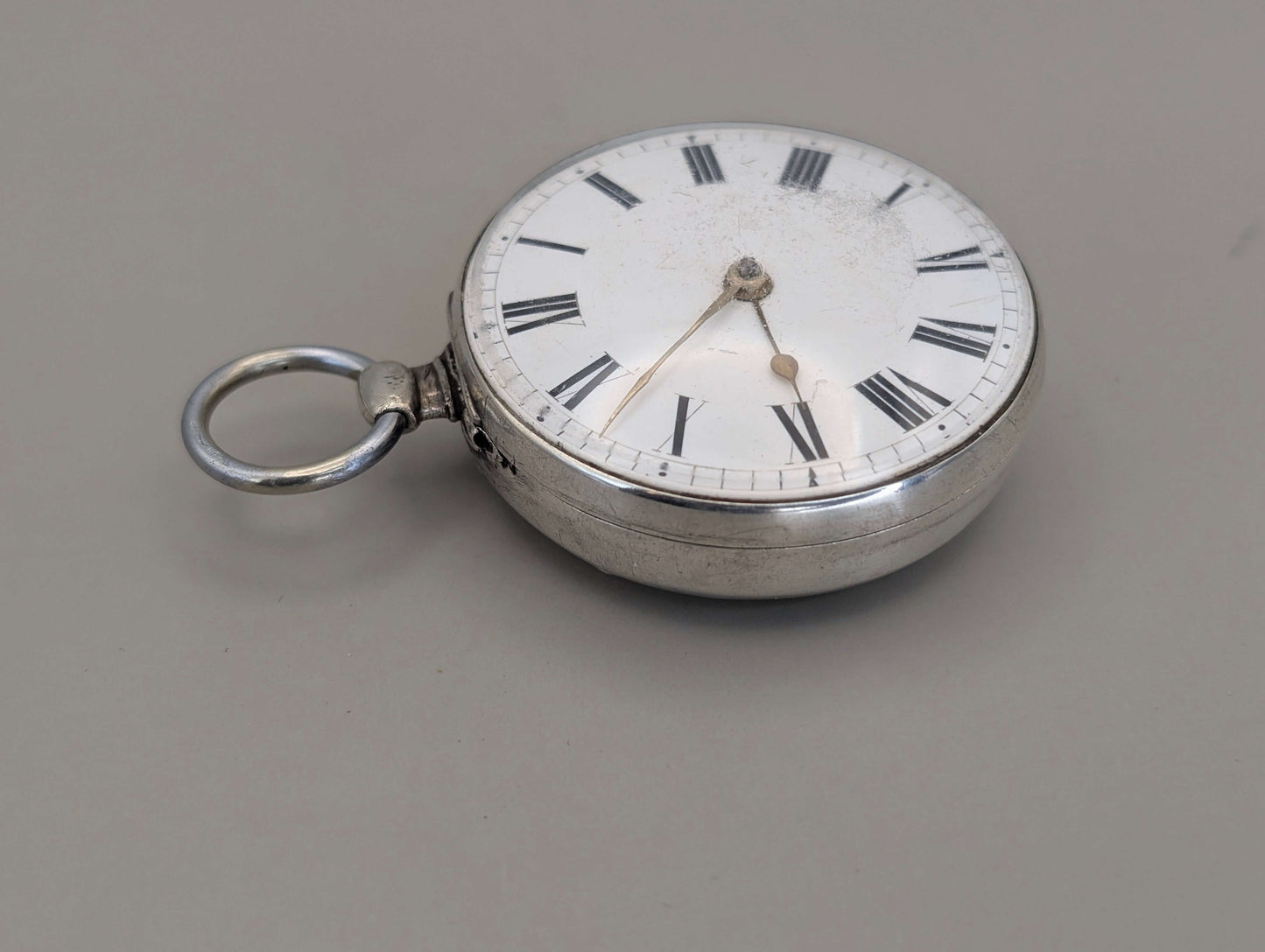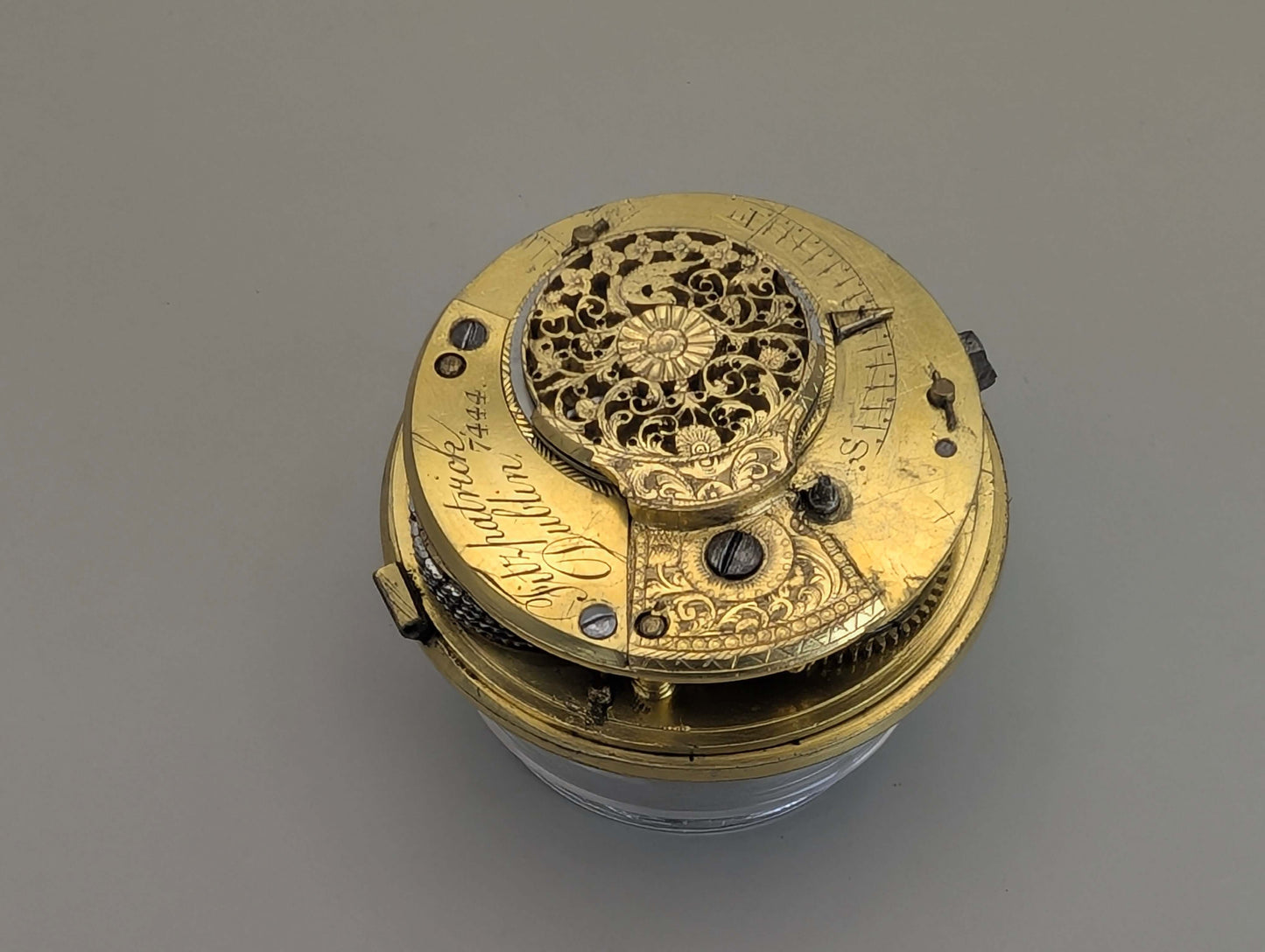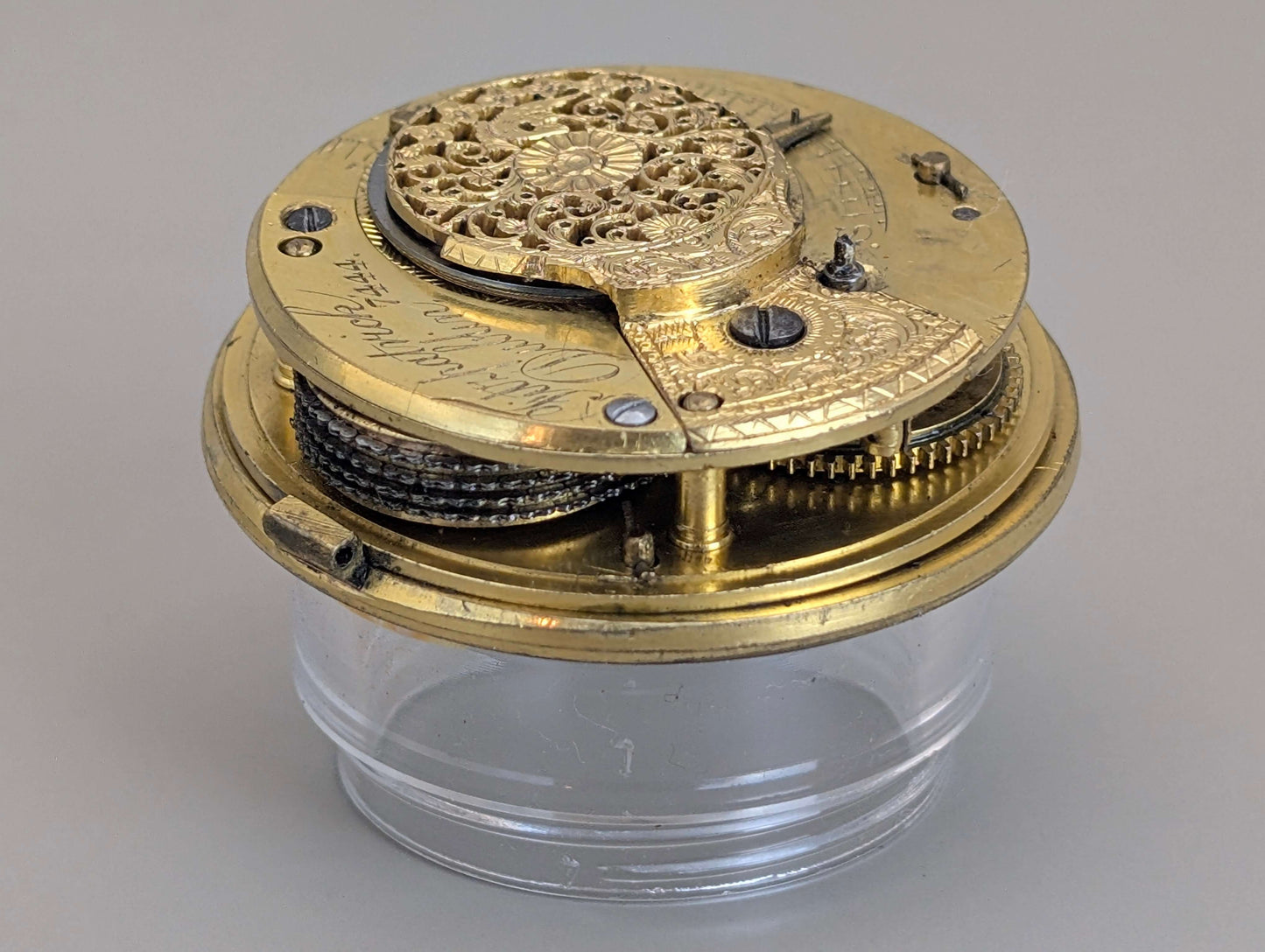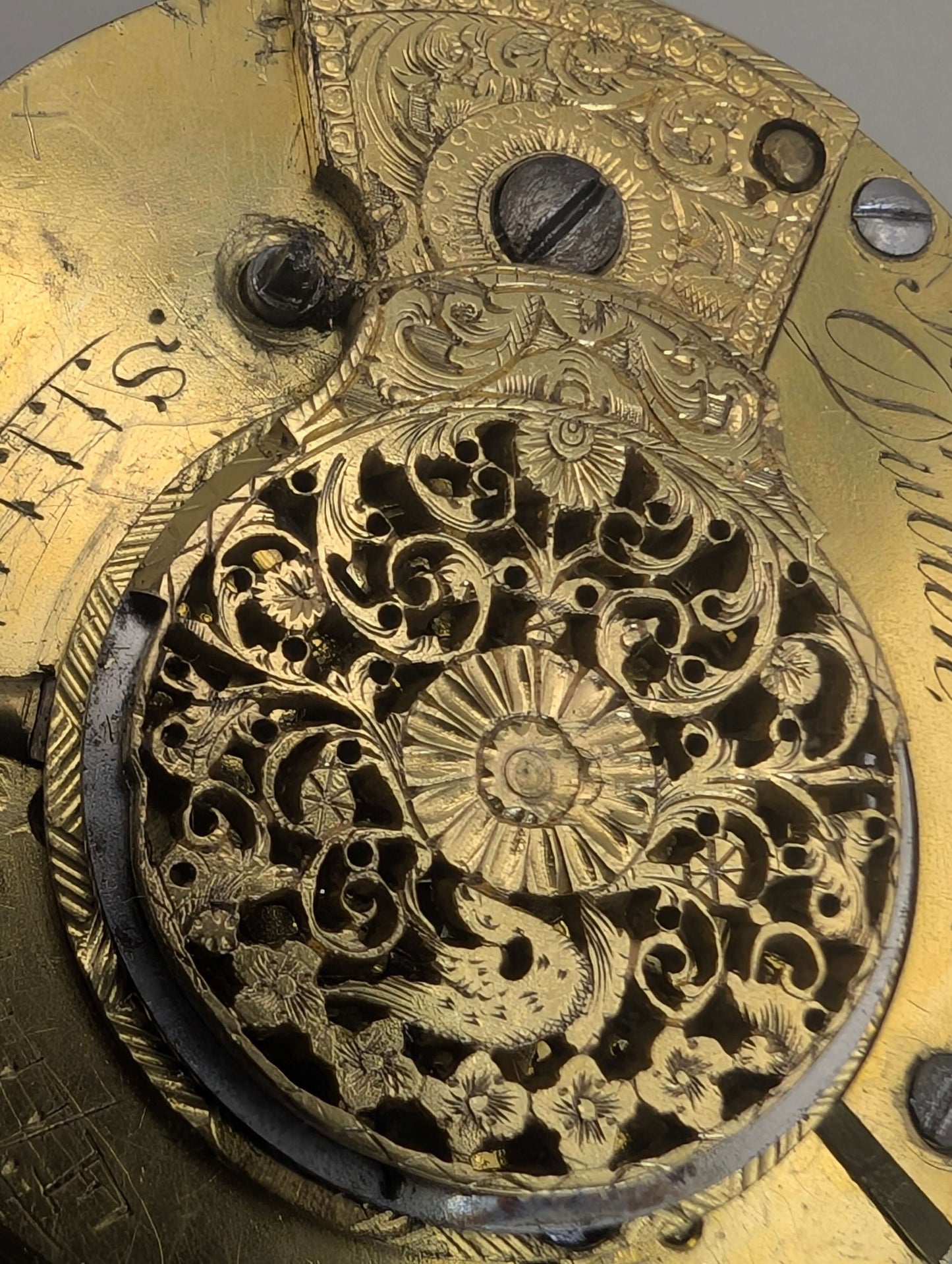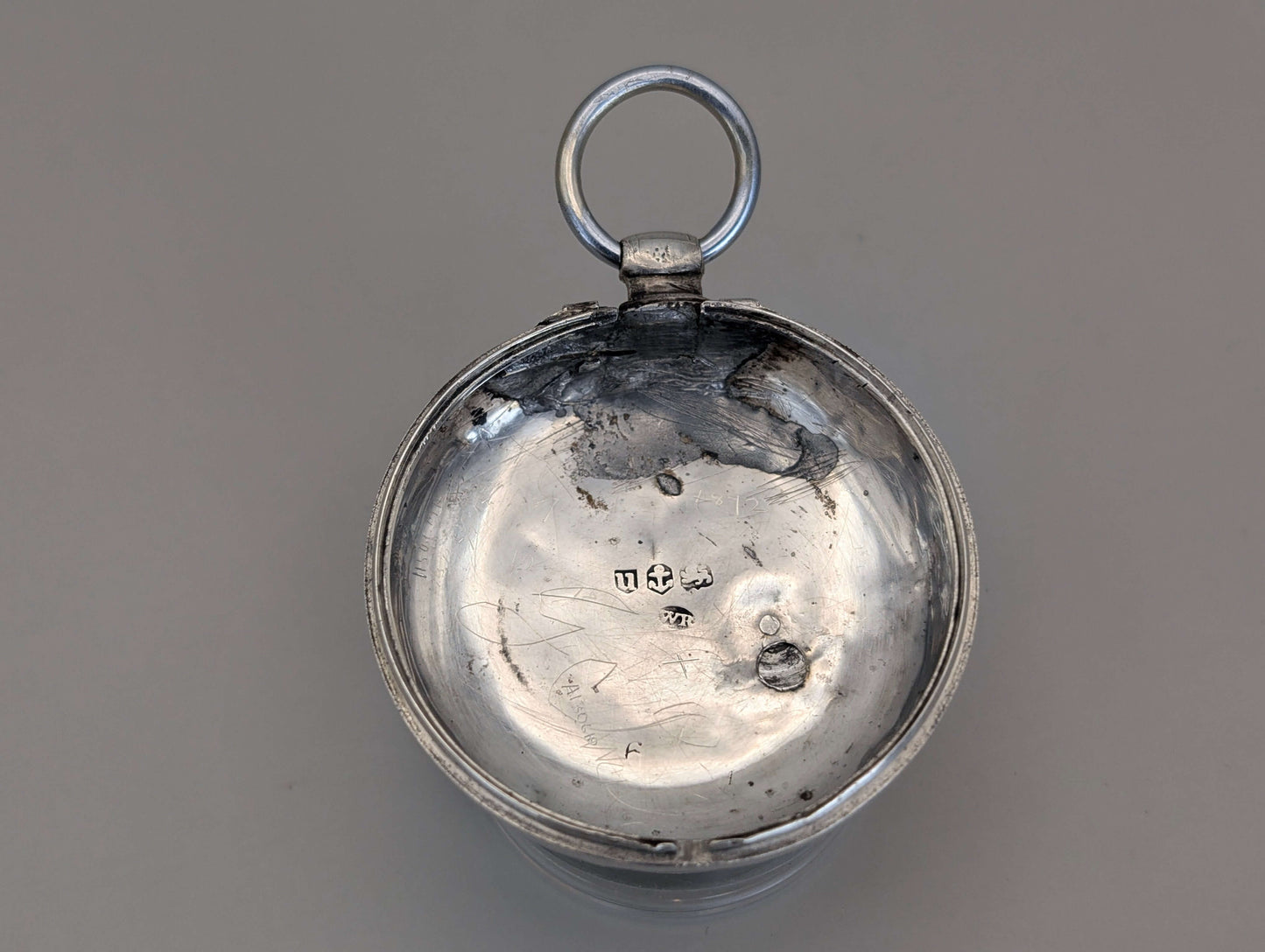Fitzpatrick Dublin
Rare "Working" Fitzpatrick Dublin Pair-Cased Sterling Silver Fusee Pocket Watch – 1818
Rare "Working" Fitzpatrick Dublin Pair-Cased Sterling Silver Fusee Pocket Watch – 1818
Working 1818 Sterling Silver Fusee Watch with Papers & Tin
Careful packaging & postage insurance provided
Item Specifics
Material: Sterling Silver (.925)
Colour: Silver with white enamel dial and black Roman numerals
Origin: Dublin, Ireland
Era/Period: Georgian, 1818
Maker's Mark/Signature: Fitzpatrick, Dublin, Serial No. 7444 / Case by William Ryley, Birmingham
Description
This early 19th-century Irish fusee pocket watch is a striking testament to the craftsmanship, technical skill, and artistry of Georgian watchmakers.
Produced in 1818 by Fitzpatrick of Dublin, it features a hand-finished movement contained within its original sterling silver pair-cased structure, a form designed to protect valuable mechanisms from dust and wear.
The watch showcases a pierced and engraved balance cock with intricate floral motifs, an original intact fusee chain, and finely engraved movement plates that shimmer softly under light.
It captures attention immediately with its crisp Roman numeral dial, framed beneath its domed mineral glass, and the soft, rhythmic ticking of a mechanism that has marked over two centuries of history.
Still fully operational, this timepiece winds, ticks, and sets correctly, providing a direct mechanical link to the Georgian era.
Condition & Quality Rating
⭐ Quality Rating: Excellent (★★★★☆)
This watch is in excellent condition, particularly given its age of over 200 years.
The movement has been lightly and carefully cleaned, preserving its originality while enhancing visibility of the engraving and construction details.
The enamel dial displays only minor surface marks, with no cracks, chips, or hairlines, and remains bright and legible.
The original domed mineral glass shows light, period-appropriate scratching consistent with centuries of careful handling.
Both the inner and outer sterling silver cases retain strong, legible hallmarks and show only minor wear. The hinges function smoothly, and the case closes securely as designed.
The watch sets correctly using a key (not included) and ticks reliably when wound, although minor timing adjustments may be desired for daily use.
Please consult the provided photographs for a detailed visual representation of the condition.
About Fitzpatrick, Dublin
Fitzpatrick was part of a respected and skilled group of horologists working in Dublin during the early 19th century, a period when the city rivalled London for fine watchmaking.
Although fewer records survive about Fitzpatrick compared to larger makers, the quality of his surviving watches speaks volumes about his reputation at the time.
Dublin watchmakers often supplied the merchant and professional classes, crafting bespoke and precision pieces in limited numbers.
Surviving examples signed "Fitzpatrick, Dublin" are rare today, often found only in well-curated private collections or specialised horological auctions.
About William Ryley, Case Maker
William Ryley was a respected silversmith and case maker active in Birmingham during the early 19th century.
Working at the heart of Britain’s silver trade, Ryley produced high-quality sterling silver watch cases for leading watchmakers across England and Ireland.
His maker’s mark, found clearly stamped on both the inner and outer cases of this watch, is a hallmark of craftsmanship and durability.
Each of his cases was hand-formed and finished to exacting standards, designed to protect the delicate fusee movements they encased.
Today, Ryley's cases are valued for their precision, strong hallmarking, and elegant construction.
About H. Carter, Watchmaker of Ripon
H. Carter was a 19th-century watch and clock maker and repairer based in Ripon, North Yorkshire.
Although little is recorded about Carter’s life, surviving watch papers like those found with this piece confirm that his business operated throughout the mid-1800s.
His papers advertise services such as cleaning, repairing, and adjusting lever and plain watches.
The two original papers included with this watch, bearing handwritten dates of June 1848 and July 1851, show that the watch was professionally serviced during its working life.
This tangible link to Carter’s workshop adds another rich layer of history, illustrating the network of skilled craftsmen who maintained fine timepieces across Britain.
Collectability
This pocket watch offers an exceptional glimpse into Irish horological history.
Its survival in working condition, with original, matching pair cases, elevates it beyond most available examples.
The inclusion of its historic watch papers, dated June 1848 and July 1851, along with its original metal tin, makes this a uniquely complete ensemble.
Authentic Irish fusee pocket watches, particularly those retaining original documentation and service history, have become increasingly scarce.
The provenance from H. Carter, a 19th-century watchmaker based in Ripon, further enriches the piece’s historical narrative and appeal.
For collectors of Georgian horology, Irish antiques, or early precision instruments, this watch represents a rare and meaningful acquisition.
How This Item Was Made
This watch was crafted almost entirely by hand using traditional techniques perfected over generations of skilled artisans.
The movement was painstakingly constructed from brass and steel components, with the delicate piercing and engraving on the balance cock completed using hand tools under magnification.
The fusee mechanism was an advanced system used to regulate the torque of the mainspring, ensuring more accurate timekeeping than earlier designs.
Before the widespread adoption of the lever escapement, the fusee was the premier technology for pocket watches intended to offer consistent accuracy.
The sterling silver inner and outer cases were produced by William Ryley of Birmingham, as indicated by clear hallmarks and his registered maker’s punch.
Ryley was known for producing high-quality cases for fine English and Irish watches, combining strength with refined construction.
Constructing a complete timepiece of this calibre required collaboration among specialist tradespeople — including casemakers, engravers, fusee chain makers, and final assemblers — and would have taken several weeks to complete.
Additional Notes
The hallmark ('u') on both cases, along with the anchor assay mark, confirms the Birmingham origin and the date of 1818.
The matching serial numbers between the movement and case strongly suggest that this watch remains entirely original and unaltered.
The light surface marks on the enamel dial and minor scratches on the mineral glass are consistent with careful use over its long life and serve as tangible evidence of its journey through time.
Accompanying the watch are two original printed watch papers from H. Carter, Watch and Clock Maker, Ripon.
These papers, once tucked inside the outer case to protect the movement and advertise Carter's services, are rare survivals seldom found with watches today.
Importantly, handwritten service dates of June 1848 and July 1851 are visible on the reverse sides of the papers under UV light.
These entries show that the watch was actively maintained more than 30 years after its manufacture, significantly enhancing its provenance and appeal.
Also included is the original metal storage tin with lining cloth, providing further context and protection for this remarkable piece.
Recommendations for Care
Wind gently using a correctly sized key, ensuring slow, steady turns to avoid placing undue strain on the mechanism.
Take care not to overwind the watch, as antique mainsprings can be sensitive.
Store the watch in a dry, padded case away from direct sunlight, excessive humidity, or strong magnetic fields.
Avoid exposure to moisture and extreme temperatures.
Clean the case and glass only with a soft, dry cloth.
Professional servicing by a horologist experienced with antique fusee watches is recommended if regular running or adjustment is desired.
Share in the Joy of Discovery! – with The Recollection Room
At The Recollection Room, each piece is a portal to another time.
This Fitzpatrick pocket watch is not just a beautiful object but a living link to Irish artistry, Georgian craftsmanship, and the enduring human fascination with time itself.
We invite you to make it part of your collection, honouring its journey and preserving its story for future generations.
Share
Couldn't load pickup availability
